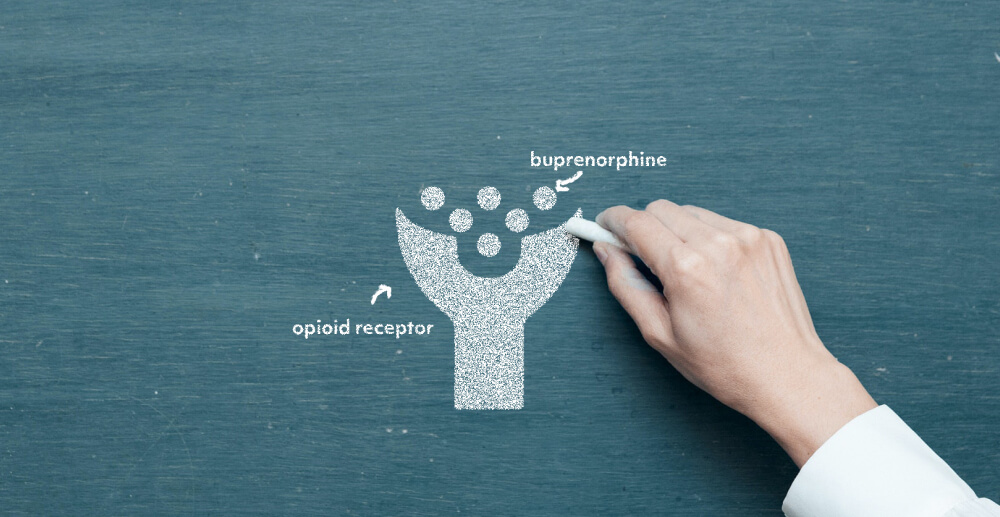When my teammates and I respond to messages and comments on social media, I see one particular phrase over and over again: “Just another addiction.” I want to counter the claim that taking buprenorphine to treat opioid use disorder is the same as addictive drug use, because it’s a really misleading statement. That means we need to dig into the question, “Is Suboxone addictive?”
What is Suboxone?
Suboxone (buprenorphine/naloxone) is a medication used to treat opioid use disorder (OUD). It is taken by dissolving it under the tongue (sublingually). Buprenorphine is the main ingredient in Suboxone. It is a partial opioid agonist. This means buprenorphine bonds to the mu opioid receptors in the brain (just like other opioids) but it only partially activates them (unlike other opioids). This partial activation allows it to relieve withdrawal symptoms and cravings. In people with OUD, it generally does not activate the receptors enough to cause euphoria, or “high.”
What about the other active ingredient? Naloxone is an opioid antagonist. It is not an opioid at all, but it bonds to the opioid receptors and blocks them off so that no opioids can activate them. When taken sublingually as directed, the naloxone is not absorbed by the body and it has no effect. If Suboxone is taken incorrectly (snorted or injected), the naloxone does have an effect—it blocks the buprenorphine from reaching the opioid receptors. So there is not only no high, but the naloxone may cause precipitated withdrawal (intense withdrawal symptoms set off by a substance).
How does buprenorphine affect people with OUD differently?
You’ll notice that in the section above, I said that Suboxone relieves withdrawals and cravings but usually doesn’t cause euphoria in people using it to treat OUD, whose bodies have become accustomed to the effect of opioids. What about in people who don’t have OUD?
There are people who misuse buprenorphine. One study found that among people who misuse buprenorphine and do not have OUD, the most common motivations were “to relieve physical pain” (29.3%) and “to feel good or get high” (18.1%). So people who haven’t developed a tolerance to opioids or who haven’t regularly used full opioid agonists (like heroin, fentanyl, or hydrocodone) can and often do feel euphoria if they take buprenorphine.
So is Suboxone addictive?
Any substance that affects your brain chemistry has the potential to be addicting. According to the DSM-5, diagnosing opioid use disorder looks for at least two of the following criteria:
- Taking larger amounts or taking drugs over a longer period than intended
- Persistent desire or unsuccessful efforts to cut down or control opioid use
- Spending a great deal of time obtaining or using the opioid or recovering from its effects
- Craving, or a strong desire or urge to use opioids
- Problems fulfilling obligations at work, school, or home
- Continued opioid use despite having recurring social or interpersonal problems
- Giving up or reducing activities because of opioid use
- Using opioids in physically hazardous situations such as driving while under the influence of opiates
- Continued opioid use despite ongoing physical or psychological problem likely to have been caused or worsened by opioids
- Tolerance (i.e., need for increased amounts or diminished effect with continued use of the same amount)
- Experiencing withdrawal (opioid withdrawal syndrome) or taking opioids (or a closely related substance) to relieve or avoid withdrawal symptoms
(Quoted from the National Institutes of Health.)
The diagnostic guidelines specify that, “Tolerance and withdrawal criteria for OUD should not be applied if individual is taking prescribed opioids solely under medical supervision.” This means that the fact that most people will experience withdrawal symptoms if they don’t taper their Suboxone dose properly is not a sign of addiction.
Using the list above can help determine if a person is using Suboxone addictively. For people who are using Suboxone as part of an OUD treatment program, the only ones that usually apply are the two (tolerance and withdrawal) that are specifically excluded for people taking their meds as directed. Crucially, for people with OUD, taking Suboxone decreases or eliminates the rest of that list of diagnostic criteria.
The bottom line
If you or someone you care about is misusing buprenorphine, it’s a good idea to take a look at the diagnostic criteria for addiction listed above. If using this substance is negatively affecting your life, seek help in tapering off of it. However, if you or your loved one is taking Suboxone as directed as part of OUD treatment and are not experiencing negative life consequences, there is no reason to worry about becoming addicted to Suboxone.









